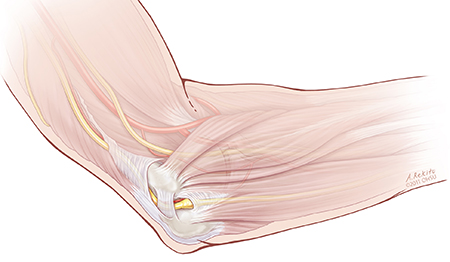Cubital Tunnel Syndrome
The OHSU Nerve Center offers access to neurologists, surgeons and rehabilitation specialists who work as a team to relieve pain from cubital tunnel syndrome. You’ll find:
- Providers specially trained to treat cubital tunnel syndrome, which affects muscle movement.
- Rehabilitation specialists with expertise in nerves, and in the arm, elbow and hand to help you find relief at work and home.
- State-of-the-art diagnostic testing to evaluate nerve damage.
- The latest treatment options, including a less-invasive surgery that’s not widely available.
Understanding cubital tunnel syndrome
What is cubital tunnel syndrome?
Cubital tunnel syndrome is a peripheral nerve disorder in which the ulnar nerve is compressed, or pinched. This condition is also called ulnar nerve entrapment at the elbow.
The ulnar nerve, commonly called the funny bone, runs from the neck to the fingers through a tube, or tunnel. When it is compressed, it doesn’t get enough blood flow to work properly. Over time, compression causes nerve damage that leads to pain and numbness in the forearm or hand.
Ulnar nerve entrapment (cubital tunnel syndrome)

Who gets cubital tunnel syndrome?
Cubital tunnel syndrome is the second most common peripheral nerve compression disorder, after carpal tunnel syndrome. It’s relatively rare, though. Each year, doctors diagnose fewer than 25 cases for every 100,000 people.
Cubital tunnel syndrome develops in people of all ages. It affects twice as many men as women, though researchers don’t know why.
You may be at higher risk if you:
- Work in a job that requires repetitive wrist motions.
- Spend a lot of time with your elbow flexed (for example, while talking on the phone).
- Have had trauma, such as a blow, to your ulnar nerve.
- Have physical differences that increase risk, such as a variation in the cubital tunnel shape.
- Are obese or have diabetes, rheumatoid arthritis or thyroid disease.
What causes cubital tunnel syndrome?
Holding a position or tool for an extended period of time, or repeating the same task over time, can stretch or pinch the ulnar nerve. Damage to nerve fibers or chronic fluid buildup can also put pressure on the nerve.
Cubital tunnel syndrome symptoms
If you notice symptoms, it’s best to talk with a doctor right away. Left untreated, cubital tunnel syndrome can leave permanent nerve damage.
Symptoms include:
- Numbness, “pins and needles” or tingling in your hand and fingers
- Pain that burns or feels like an ice pick in your forearm
- Weakness in your ring and pinkie fingers
- Difficulty pinching your thumb and pinkie together
Diagnosing cubital tunnel syndrome
At your first visit, our team will do a thorough physical exam and ask you about your medical history. Tests may include:
Electromyography: Your doctor sends a mild electrical current to a needle placed in the muscle. It measures how well the nerve is supplying electrical signals that cause muscle to contract. If the nerve isn’t working properly, this helps locate nerve damage.
Nerve conduction velocity test, or nerve conduction study: Your doctor stimulates the nerve with an electrical impulse and measures how fast it moves through the nerve. Nerve signals that are slower than expected can indicate the type and severity of damage.
Learn more about tests for nerve disorders.
Cubital tunnel syndrome treatments
Nearly 85% of cubital tunnel syndrome patients find relief with treatment. Treatment at OHSU may include:
- Splinting or bracing: A splint to block the elbow from bending at night can reduce nerve injury and pain. This treatment aims to correct your arm position and is usually effective after about a month. A protective pad over the elbow can prevent pressure on the nerve during the day.
- Rehabilitation therapy: We can help you learn how to move and work in ways that avoid pain and nerve injury. Our specialists include experts in neurologic rehabilitation and in hand/arm/elbow therapy.
- Surgery: In severe cases, your care team may recommend surgery to release pressure on the nerve. This can provide permanent relief after several months of recovery. Our expert surgeons can do this surgery through a small incision.
Learn more
- Cubital Tunnel Syndrome, American Society for Surgery of the Hand
- Ulnar Nerve Entrapment at the Elbow (Cubital Tunnel Syndrome), American Academy of Orthopaedic Surgeons
For patients
Referral: To become a patient, please ask your doctor for a referral.
Locations
Parking is free for patients and their visitors.
We offer clinics for nerve conditions on our Marquam Hill and South Waterfront campuses.
Refer a patient
- Refer your patient to OHSU.
- Call 503-494-4567 to seek provider-to-provider advice.